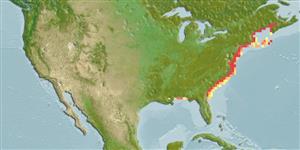Common names from other countries
Environment: milieu / climate zone / depth range / distribution range
Ecología
; rango de profundidad 0 - 36 m (Ref. 83435). Subtropical, preferred 17°C (Ref. 107945); 49°N - 30°N, 80°E - 65°W (Ref. 83435)
Atlantic and the Mediterranean.
Length at first maturity / Tamaño / Peso / Age
Maturity: Lm ? range ? - ? cm Max length : 13.0 cm TL macho / no sexado; (Ref. 7726); edad máxima reportada: 9 años (Ref. 2823)
Maximum depth from Ref. 104365. Found buried in muddy sediment on the lower shore and shallow sublittoral and in bays and estuaries. Prefers sandy environments to depths of 15 m (Ref. 78574).
Life cycle and mating behavior
Madurez | Reproducción | Puesta | Huevos | Fecundidad | Larva
Members of the class Bivalvia are mostly gonochoric, some are protandric hermaphrodites. Life cycle: Embryos develop into free-swimming trocophore larvae, succeeded by the bivalve veliger, resembling a miniature clam.
Harvey-Clark, C. 1997. (Ref. 7726)
IUCN Red List Status (Ref. 130435)
CITES status (Ref. 108899)
Not Evaluated
Not Evaluated
Human uses
Pesquerías: comercial
FAO - Acuicultura: producción, species profile; pesquerías: landings, species profile | FishSource | Sea Around Us
Herramientas
Fuentes de Internet
Estimates based on models
Preferred temperature
(Ref.
115969): 8.8 - 23.7, mean 13.2 (based on 120 cells).
Resiliencia
Alto, población duplicada en un tiempo mínimo inferior a 15 meses (K=0.16-0.5; tmax=9).
Prior r = 0.43, 95% CL = 0.28 - 0.65, Based on 3 data-limited stock assessments.
Vulnerability
Low to moderate vulnerability (25 of 100).
